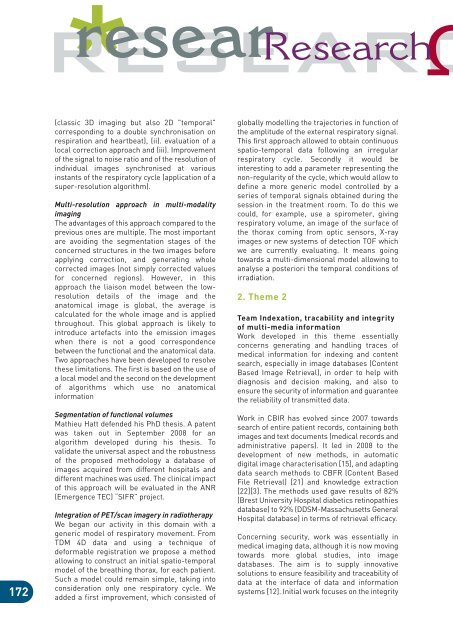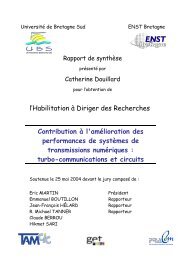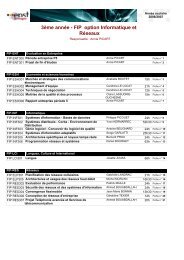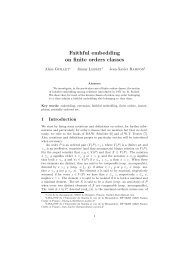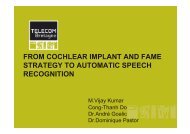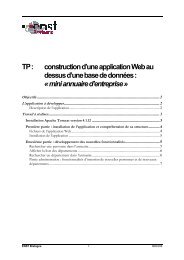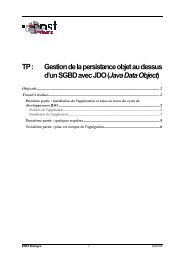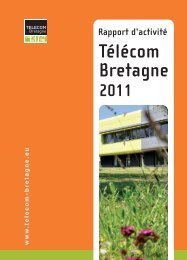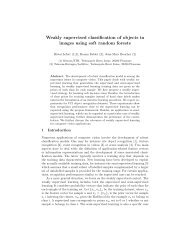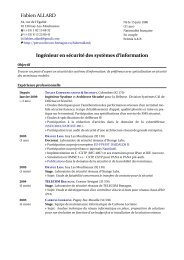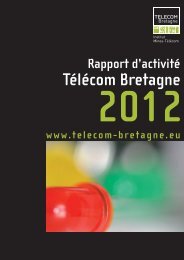researResearch - Télécom Bretagne
researResearch - Télécom Bretagne
researResearch - Télécom Bretagne
Create successful ePaper yourself
Turn your PDF publications into a flip-book with our unique Google optimized e-Paper software.
esearc<br />
<strong>researResearch</strong><br />
172<br />
(classic 3D imaging but also 2D "temporal"<br />
corresponding to a double synchronisation on<br />
respiration and heartbeat), (ii). evaluation of a<br />
local correction approach and (iii). Improvement<br />
of the signal to noise ratio and of the resolution of<br />
individual images synchronised at various<br />
instants of the respiratory cycle (application of a<br />
super-resolution algorithm).<br />
Multi-resolution approach in multi-modality<br />
imaging<br />
The advantages of this approach compared to the<br />
previous ones are multiple. The most important<br />
are avoiding the segmentation stages of the<br />
concerned structures in the two images before<br />
applying correction, and generating whole<br />
corrected images (not simply corrected values<br />
for concerned regions). However, in this<br />
approach the liaison model between the lowresolution<br />
details of the image and the<br />
anatomical image is global, the average is<br />
calculated for the whole image and is applied<br />
throughout. This global approach is likely to<br />
introduce artefacts into the emission images<br />
when there is not a good correspondence<br />
between the functional and the anatomical data.<br />
Two approaches have been developed to resolve<br />
these limitations. The first is based on the use of<br />
a local model and the second on the development<br />
of algorithms which use no anatomical<br />
information<br />
Segmentation of functional volumes<br />
Mathieu Hatt defended his PhD thesis. A patent<br />
was taken out in September 2008 for an<br />
algorithm developed during his thesis. To<br />
validate the universal aspect and the robustness<br />
of the proposed methodology a database of<br />
images acquired from different hospitals and<br />
different machines was used. The clinical impact<br />
of this approach will be evaluated in the ANR<br />
(Emergence TEC) “SIFR” project.<br />
Integration of PET/scan imagery in radiotherapy<br />
We began our activity in this domain with a<br />
generic model of respiratory movement. From<br />
TDM 4D data and using a technique of<br />
deformable registration we propose a method<br />
allowing to construct an initial spatio-temporal<br />
model of the breathing thorax, for each patient.<br />
Such a model could remain simple, taking into<br />
consideration only one respiratory cycle. We<br />
added a first improvement, which consisted of<br />
globally modelling the trajectories in function of<br />
the amplitude of the external respiratory signal.<br />
This first approach allowed to obtain continuous<br />
spatio-temporal data following an irregular<br />
respiratory cycle. Secondly it would be<br />
interesting to add a parameter representing the<br />
non-regularity of the cycle, which would allow to<br />
define a more generic model controlled by a<br />
series of temporal signals obtained during the<br />
session in the treatment room. To do this we<br />
could, for example, use a spirometer, giving<br />
respiratory volume, an image of the surface of<br />
the thorax coming from optic sensors, X-ray<br />
images or new systems of detection TOF which<br />
we are currently evaluating. It means going<br />
towards a multi-dimensional model allowing to<br />
analyse a posteriori the temporal conditions of<br />
irradiation.<br />
2. Theme 2<br />
Team Indexation, tracability and integrity<br />
of multi-media information<br />
Work developed in this theme essentially<br />
concerns generating and handling traces of<br />
medical information for indexing and content<br />
search, especially in image databases (Content<br />
Based Image Retrieval), in order to help with<br />
diagnosis and decision making, and also to<br />
ensure the security of information and guarantee<br />
the reliability of transmitted data.<br />
Work in CBIR has evolved since 2007 towards<br />
search of entire patient records, containing both<br />
images and text documents (medical records and<br />
administrative papers). It led in 2008 to the<br />
development of new methods, in automatic<br />
digital image characterisation [15], and adapting<br />
data search methods to CBFR (Content Based<br />
File Retrieval) [21] and knowledge extraction<br />
[22][3]. The methods used gave results of 82%<br />
(Brest University Hospital diabetics retinopathies<br />
database) to 92% (DDSM-Massachusetts General<br />
Hospital database) in terms of retrieval efficacy.<br />
Concerning security, work was essentially in<br />
medical imaging data, although it is now moving<br />
towards more global studies, into image<br />
databases. The aim is to supply innovative<br />
solutions to ensure feasibility and traceability of<br />
data at the interface of data and information<br />
systems [12]. Initial work focuses on the integrity


